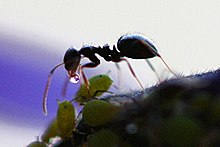
Back مغثر Arabic Мядзвяная падзь Byelorussian Мана (секрет) Bulgarian Mel de melada Catalan Medovice Czech Honningdug Danish Honigtau German Mielroso Esperanto Mielada Spanish Ezti-ihintz Basque


Honeydew is a sugar-rich sticky liquid, secreted by aphids, some scale insects, and many other true bugs and some other insects as they feed on plant sap. When their mouthpart penetrates the phloem, the sugary, high-pressure liquid is forced out of the anus of the insects, allowing them to rapidly process the large volume of sap required to extract essential nutrients present at low concentrations. Honeydew is particularly common as a secretion in hemipteran insects and is often the basis for trophobiosis.[1] Some caterpillars of Lycaenidae butterflies and some moths also produce honeydew.[2] In addition to various sugars, honeydew contains small amounts of amino acids, other organic compounds, and inorganic salts with its precise makeup affected by factors such as insect species, host plant species, and whether a symbiotic organism is present.[1][3]
Honeydew-producing insects, like cicadas, pierce phloem ducts to access the sugar rich sap. The sap continues to bleed after the insects have moved on, leaving a white sugar crust called manna.[4] Ants may collect, or "milk", honeydew directly from aphids and other honeydew producers, which benefit from their presence due to their driving away predators such as lady beetles or parasitic wasps—see Crematogaster peringueyi. Animals and plants in a mutually symbiotic arrangement with ants are called Myrmecophiles.
In Madagascar, some gecko species in the genera Phelsuma and Lygodactylus are known to approach flatid plant-hoppers on tree-trunks from below and induce them to excrete honeydew by head nodding behaviour. The plant-hopper then raises its abdomen and excretes a drop of honeydew almost right onto the snout of the gecko.[5]
Honeydew can cause sooty mold on many ornamental plants. It also contaminates vehicles parked beneath trees, and can then be difficult to remove from glass and bodywork. Honeydew is also secreted by certain fungi, particularly ergot.[6] Honeydew is collected by certain species of birds, mosquitoes,[7][8] wasps, stingless bees[9] and honey bees, which process it into a dark, strong honey (honeydew honey). This is highly prized in parts of Europe and Asia for its reputed medicinal value. Parachartergus fraternus, a eusocial wasp species, collects honeydew to feed to their growing larvae.[10] Recent research has also documented the use of honeydew by over 40 species of wild, native, mostly solitary bees in California.[11]
- ^ a b Delabie JH (2001). "Trophobiosis Between Formicidae and Hemiptera (Sternorrhyncha and Auchenorrhyncha): an Overview" (PDF). Neotropical Entomology. 30 (4): 501–516. doi:10.1080/00222930150215378. S2CID 84918015.
- ^ Maschwitz U, Dumpert K, Tuck KR (1986). "Ants feeding on anal exudate from tortricid larvae: a new type of trophobiosis". Journal of Natural History. 20 (5): 1041–1050. doi:10.1080/00222938600770751.
- ^ Shaaban, Basel; Seeburger, Victoria; Schroeder, Annette; Lohaus, Gertrud (24 January 2020). "Sugar, amino acid and inorganic ion profiling of the honeydew from different hemipteran species feeding on Abies alba and Picea abies". PLOS ONE. 15 (1): e0228171. doi:10.1371/journal.pone.0228171. PMC 6980476.
- ^ Lee AK (1985-03-21). Evolutionary Ecology of Marsupials. Cambridge University Press. p. 33. ISBN 9780521252928. Retrieved 25 August 2019.
- ^ Fölling M, Knogge C, Böhme W (February 2001). "Geckos are milking honeydew-producing planthoppers in Madagascar". Journal of Natural History. 35 (2): 279–84. doi:10.1080/00222930150215378. S2CID 84918015.
- ^ Ergot of Rye Archived 2018-08-09 at the Wayback Machine, APSnet.org, The American Phytopathological Society
- ^ Peach DA, Gries R, Young N, Lakes R, Galloway E, Alamsetti SK, et al. (February 2019). "Aedes aegypti (L.) to Aphid Honeydew". Insects. 10 (2): 43. doi:10.3390/insects10020043. PMC 6409638. PMID 30717169.
- ^ Peach DA, Gries G (2019). "Mosquito phytophagy – sources exploited, ecological function, and evolutionary transition to haematophagy". Entomologia Experimentalis et Applicata. 168 (2): 120–136. doi:10.1111/eea.12852. ISSN 1570-7458.
- ^ Koch H, Corcoran C, Jonker M (2011). "Honeydew Collecting in Malagasy Stingless Bees (Hymenoptera: Apidae: Meliponini) and Observations on Competition with Invasive Ants" (PDF). African Entomology. 19 (1): 36–41. doi:10.4001/003.019.0111. S2CID 83522254. Archived from the original (PDF) on 2012-03-19.

- ^ Sidnei M, Noll FB, Zucchi R (2004). "Caste Flexibility and Variation According to the Colony Cycle in the Swarm-founding Wasp, Parachartergus Fraternus (Gribodo) (Hymenoptera: Vespidae: Epiponini)". Journal of the Kansas Entomological Society. 77 (4): 470–83. doi:10.2317/E-40.1. S2CID 84967255.
- ^ Meiners JM, Griswold TL, Harris DJ, Ernest SK (August 2017). "Bees without Flowers: Before Peak Bloom, Diverse Native Bees Find Insect-Produced Honeydew Sugars". The American Naturalist. 190 (2): 281–291. doi:10.1086/692437. PMID 28731796. S2CID 206004844.